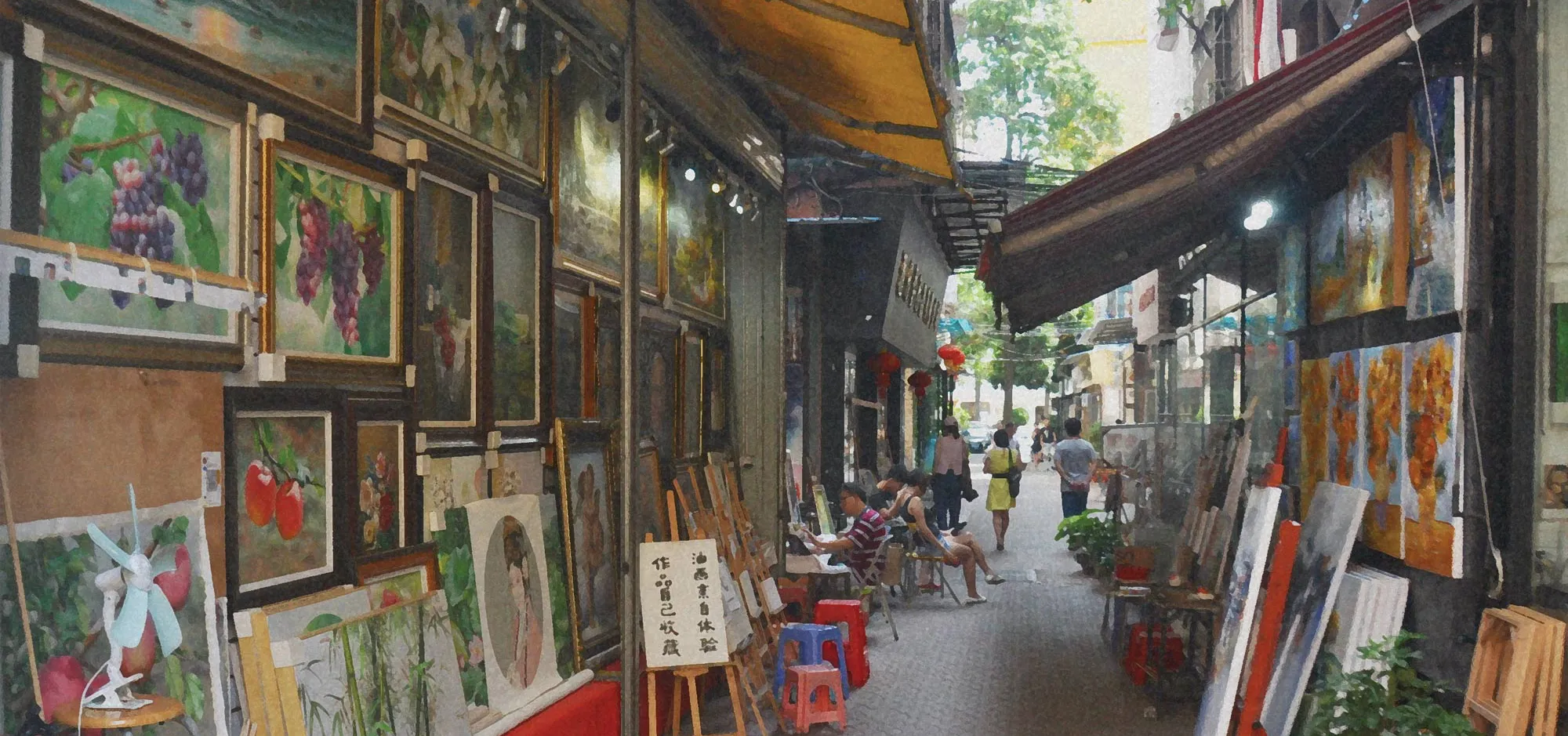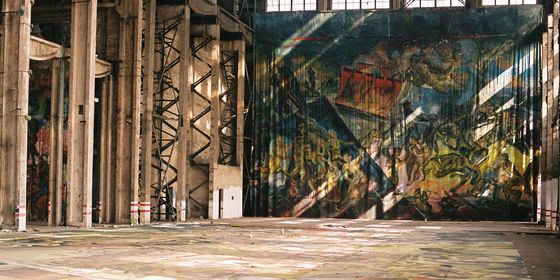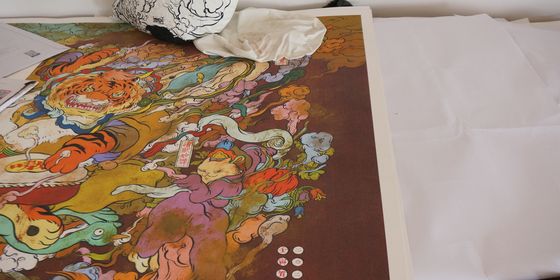Shenzhen’s Dafen village, once the world’s painting factory, faces redevelopment as an “art park.” But what will happen to its artists?
From a distance, one could take Yang Ming for a teenager. About five-foot two, his skinny arms and legs in a white T-shirt and jeans, Yang’s left shoulder is permanently hunched because of a childhood injury, making it hard to distinguish his head from behind.
With his right hand, Yang raises a paintbrush, glancing from time to time at a picture on his phone, before resuming his reproduction of a Van Gogh masterpiece, “The Harvest.” The process is sometimes interrupted by tourists who wander into the alleyway to appraise his work. At his feet lies his border collie, Didu, while above them both hangs a portrait of the dog—lying on a grassy hill, rather than a ramshackle alley. It’s one of several original works he’s trying to sell nowadays.
Yang is a “wall painter” at Shenzhen’s Dafen village, one of around 500 in an area best known for making imitation oil paintings. According to official figures, about 8,000 people in total, including artists, frame-makers, agents, and apprentices, organized in a network of 1,200 galleries and 60 painting businesses, form a 20-year-old industry in Dafen worth an estimated 4.5 billion RMB. Painters like Yang are so called because most display their wares on the walls of the area’s alleyways, many of which have erected plastic awnings in case of rain. Sometimes five or six painters can be jammed into one alley, and pedestrians need to turn sideways to inch past.
Yang is quiet and gentle—he speaks in a low voice, barely audible over the droning sound of a fan on the wall—and has a determined, stubborn side. It took Yang seven penniless years to go from being a student in a small city in Guizhou province to a painter in Dafen village in the Longgang district of Shenzhen, Guangdong province. When he started, he had no money. Embarrassed, Yang never called home and didn’t even go back for the Spring Festival.
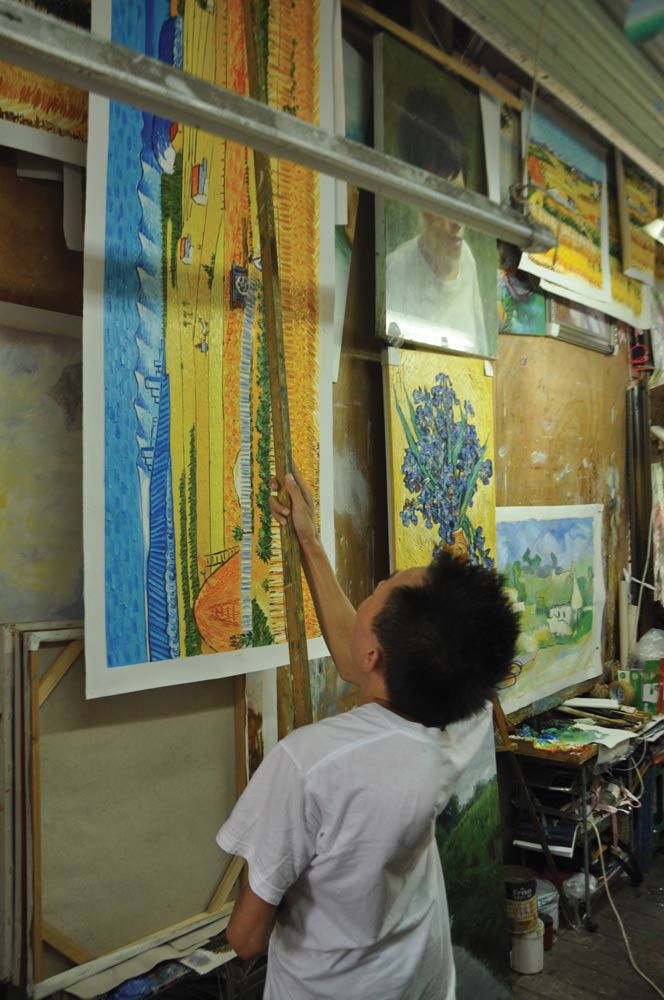
Yang Ming hangs up a painting he just finished
His sole family members, a brother and sister, only knew that he was somewhere in Guangdong, but had no idea how to contact him. For two years, they wondered if he had gone missing. Now the 31-year-old painter finally has his own stall and repeat clients. He has even taken on a student and started teaching her how to paint.
But in a few months, Yang may have to give up his stall and clients, and move, probably to a poorer part of town. The government of Longgang district has decided to rezone and “manage” the area, and unregistered residents like Yang are likely to be collateral damage.
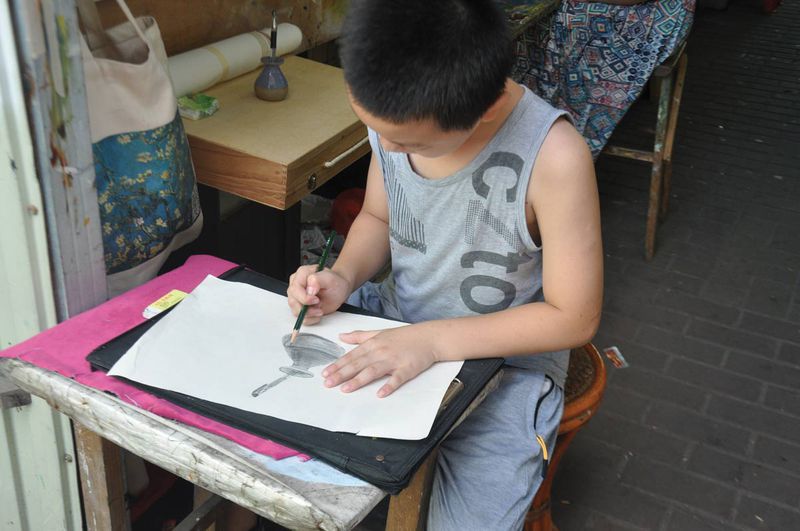
A shop owner’s son sketches in front of the gallery
Dafen used to be an ordinary village, located just outside the northeastern periphery of Shenzhen’s Special Economic Zone. In those days, migrant workers and vegetable vendors packed the area, the streets were filled with filth, and wastewater ran in gutters from the restaurants.
In 1989, Hong Kong merchant Huang Jiang introduced commercialized painting to this village. Taking advantage of ready labor and cheap property, Huang established assembly lines in the 0.4-square-kilometer area, erected studios, and recruited and trained migrant workers specifically to imitate the Western canon: Monets, Rembrandts, Van Dycks, Holbeins, Constables, Warhols, Picassos. The initiative soon granted Dafen its unique brush with fame—within a few years, it became known as the “world’s art factory,” estimated to account for between 60 to 70 percent of the global market share in oil paintings, its output appearing in hotels, expos, showrooms, and shops across the world.

Didu’s more artsy alter-ego
Yang started learning Western painting styles after graduating middle school, when an art teacher arrived at his class to recruit students. Until then, he had only seen Chinese ink paintings, not European oils or watercolors. Though he didn’t know the artist or even the name of the painting the teacher had showed him, its bright colors and boldness were enough to convince him to learn.
He came to Dafen in 2008, renting an apartment nearby with three other huagong, or “painting workers.” But, although he already had a few years’ training and could paint better than anybody back home, his work still wasn’t good enough to be sold in Dafen. “Some customers would look at me as if I don’t know the first thing about painting,” he says. “They’d say, you think a painting like this can be sold?”
Then in 2008, the global financial crisis hit South China’s manufacturing hub, and orders from overseas dropped drastically—sales were cut in half almost overnight, and official data showed that exports continued to fall annually by 52.3 percent in 2012 (today about half of Dafen’s sales are to Chinese). Many assembly-line workers were laid off, and started renting wall space in the alleyways instead. Gradually, the village became what it is today.
During this time, though, a few painters still rose above the masses. Zhao Xiaoyong lived in Dafen from 1997 to 2012, working day and night to progress from the role of merely a copyist who reproduced Van Goghs en masse, to an original artist (yishujia). He now owns three galleries, and was even the subject of a documentary, China’s Van Gogh.
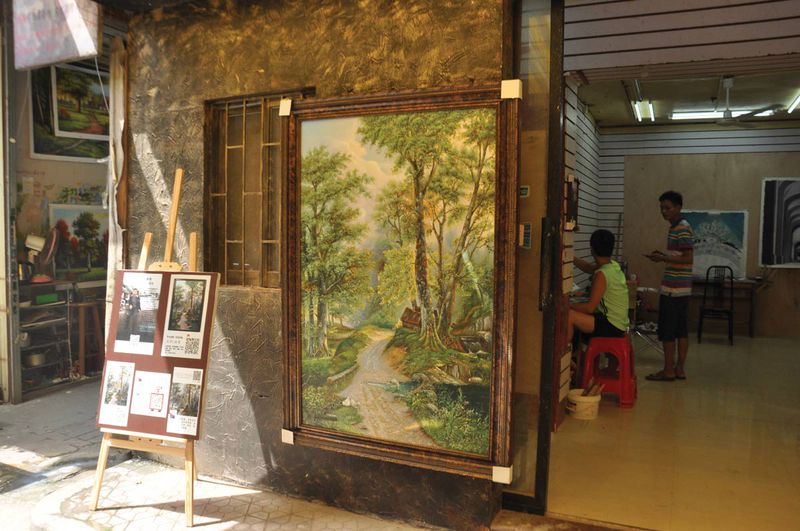
It’s Yang’s hope to become like Zhao—to move from huagong to yishujia. Yang has dabbled in portraiture and landscapes—oils like that of Didu, the collie, and his own self-portrait, which hang on the wall like advertisements of his aspirations. But Yang also knows he’s still a long way from achieving these goals. Right now, he is faced with the immediate pressure of survival, and the day-to-day work of finishing more orders for replica Western masterpieces. But from experience, he knows that Chinese customers like “bright, colorful artwork,” and he has been painting bucolic works like “The Harvest” that have proved popular with mainland clients.
Yang’s 30-year-old apprentice, Ma Chunyan, helps Yang with the orders, but had no prior experience when she began the gig last year. She didn’t even know how to sketch, though had a keen sense of color: She could look at a painting and break it down to essences, its mixture of palettes. “For example, pale green mixed with lemon yellow is emerald green. It’s almost instinctive for me, nobody ever taught me,” she says.
She chose Van Gogh to learn from, “because his paintings don’t require exquisite sketching skills; they are quite impressionist. You sketch a rough draft, then pile up layers of colors.” (Dafen’s original production-line assembly operated with a similar pattern, with each worker adding their own detail to a painting, then passing it along to the next).
Unlike Yang, who dreams of being an artist, Ma has treated the job as work from the very beginning. When she came to Dafen, she’d been practically bankrupt, trying several different fields before settling on painting, because “this is craftsmanship, a skill that can accompany you even when you get to your 60s, 70s.”
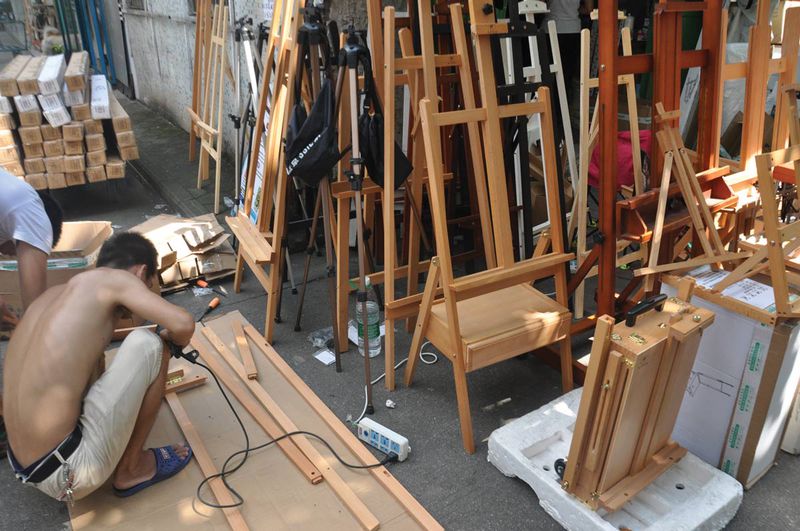
Prior to Dafen, Ma worked in the manicure-and-makeup business for 10 years, opening different shops in different places. At the peak of her business, she remembers earning up to 8,000 RMB a day. But those days didn’t last. In 2014, Ma opened up a shop in Dongguan, an industrial and textiles city in Guangdong, better known for its more underground industry. A couple of months later saw China’s widest and strictest crackdown on the “sin city’s” sex trade, an underground entertainment economy worth some 50 billion RMB a year. Ma’s own business suddenly went down the drain.
“The street my shop was on used to be flourishing, there were traffic jams all the time. Then, overnight, everybody disappeared,” she says. The economic contraction even trickled down to Dafen, whose many corporate clients included hotels in Dongguan that were closed in the crackdown. Ma herself lost 200,000 RMB. She struggled to open a salon in other cities but couldn’t make anything last, so she decided to switch fields. For the next couple of years, she tried opening a fast-food restaurant, then a Taobao shop, before finally deciding on painting.
“You have to be in control of your own life,” Ma says, though she is still making her way up in the trade. Even then, Ma has found that, once again, her success remains at the whim of the state. As early as 2006, the local Yangcheng Evening News reported that the local government has been helping Dafen’s development. Ren Xiaofeng, director of the Dafen Management Office, said the government has been focusing on three areas that contribute to the fame of Dafen: improving the environment around the village, managing the market, and providing publicity.
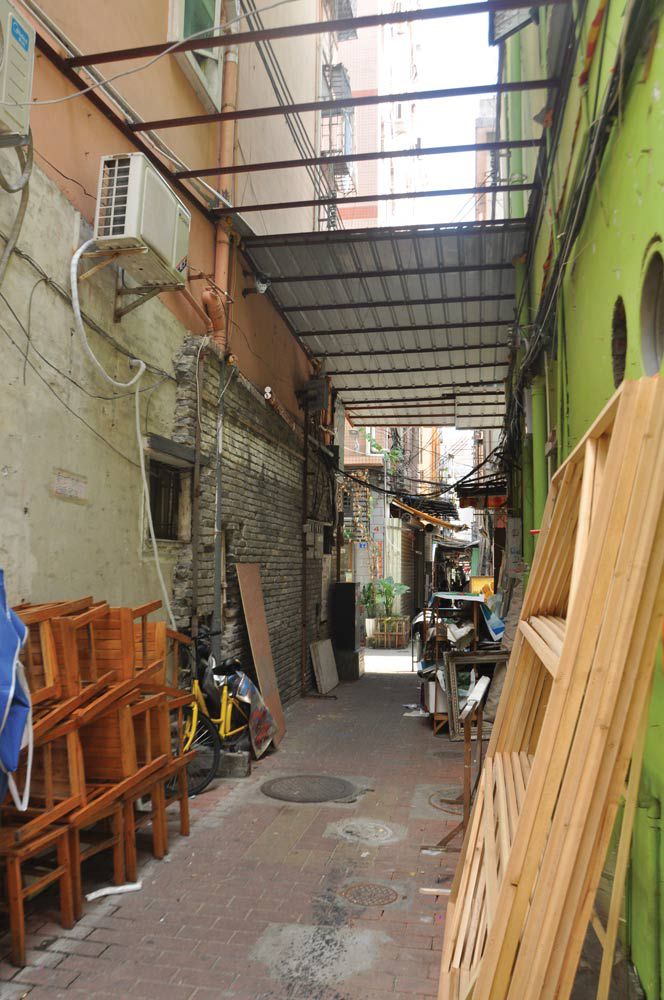
Dafen’s back alleys are clustered with artists’ supplies, which authorities say are a fire hazard
This year, a new round of regulations has begun taking effect.
In May, the Shenzhen government released a notice online saying 83 alleyways in Dafen have illegally constructed rooftops and blocked thoroughfares. There were also 148 framemakers and glass shops deemed “severe fire hazards.”
When Longgang district’s Buji neighborhood committee sent workers to clear up fire safety hazards in Dafen this summer, Ma was there to watch. She saw a group of people with ladders and hammers flood into the village, crossing the alleyways and assessing the walls, until they found the perfect one to begin tearing down. The wall was situated in a back alley, small, crowded, and remote, a perfect example of what the committee deemed a safety hazard.
The wall also happened to belong to a friend of Ma’s, who’d been out of town at that time for a job. When Ma texted him to tell what was happening, he rushed back after the team was gone to move his work elsewhere.
Two weeks later, when the demolition gang arrived for a second round, the painters were ready. An argument broke out in the narrow alleyways, jamming traffic. After a long standoff, the workers backed down. In July, Yang and a group of about 40 painters organized a meeting with local officials at an art gallery in Dafen. They raised their concerns, hoping there might be some sort of middle ground. So far, there has been no answer from the officials.

Richer painters can afford galleries where their artwork is exhibited
Wu Ruiqiu, a painter-turned-art zone planner who was president of the Dafen Fine Art Industry Association between 2006 and 2012, believes that if there’s a genuine fire concern, the government shouldn’t ease off just because some painters might not be able to make rent. But he does believe some arrangements could also be made to care for the painters’ needs.
“Why do painters work on walls? It’s because there’s not enough room in the village. If there’s space, who’d want to paint in an alley?” he asks. “Tearing down walls doesn’t solve the root of the problem. These workers have contributed to Dafen’s industry year after year. They deserve some space.”
If the issue doesn’t get solved, and his wall gets torn down, Yang will have to find a cheap studio in an even shabbier part of town. He prefers staying in Dafen, because the village itself has become a byword for fine art. New business comes through every day. If he left, he’d have to solely rely on old clients to make money.
“If it were just me, I would’ve just gone back home to find a job or clients, but now I also have my apprentice,” he argues. “I have to be responsible for her future.”

Yang shows a painting on his phone that he just entered into a local competition
According to a development plan released by the district government in 2016, Dafen will be turned into an industrial park that’s part internationalized oil painting production center, part trading platform, exhibition center, training center, and tourist attraction. There will be government offices, museums, galleries, theaters, art schools, and even hotels.
Wu said another big part of the transition is the shift from imitation artworks to original creation. If the issue of space isn’t solved, he predicts, the village will lose talent. Some painters hope that the government’s plans for a high-end art zone can include them; others are quietly planning their exit. Many have shelved their dreams of one day hitting the big time.
As this reporter was leaving, an argument broke out two streets over. A client had unrolled a canvas the size of a bed sheet on the ground, depicting a blooming plum tree against a dark red background. He pointed to the painting and shouted to someone nearby. Soon enough, a crowd of painters ducked out one by one from the nearby alleyways and gathered around.
The client shouted at the painter, demanding that he change a few details of the painting. “I did not ask for this,” he repeatedly said.
The painter took a look at the canvas, shook his head, and went back into the shadows to work on a landscape. “I shouldn’t have taken this order in the first place,” he admits. “It’s so cheap, I don’t even give a damn.”
Photography by Phoebe Zhang
The Writing on the Walls is a story from our issue, “Cloud Country.” To read the entire issue, become a subscriber and receive the full magazine.





